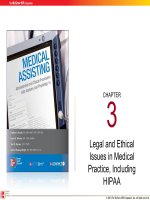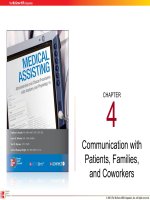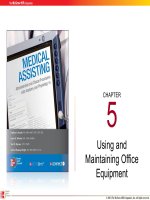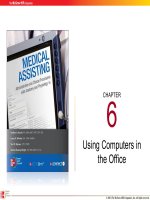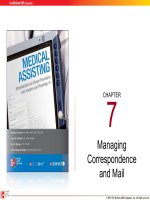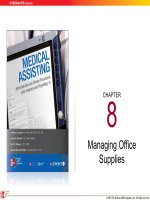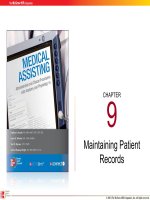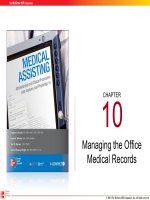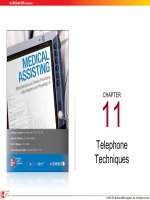Lecture Medical assisting: Administrative and clinical procedures with anatomy and physiology (4e) – Chapter 18
Bạn đang xem bản rút gọn của tài liệu. Xem và tải ngay bản đầy đủ của tài liệu tại đây (1.37 MB, 62 trang )
CHAPTER
18
Accounting for the
Medical Office
© 2011 The McGraw -Hill Com panies, Inc. A ll rights reserv e d.
18-2
Learning Outcomes
18.1 Describe traditional bookkeeping systems.
18.2 Explain the benefits of performing
bookkeeping tasks on the computer.
18.3 List banking tasks in a medical office.
18.4 Describe the logistics of accepting,
endorsing, and depositing checks from
patients and insurance companies.
© 2011 The McGraw -Hill Com panies, Inc. A ll rights reserv e d.
18-3
Learning Outcomes (cont.)
18.5 Reconcile the office’s bank statements.
18.6 Give several examples of disbursements.
18.7 Record disbursements in a disbursement
journal.
18.8 Set up and maintain a petty cash fund.
18.9 Create employee payroll information sheets.
© 2011 The McGraw -Hill Com panies, Inc. A ll rights reserv e d.
18-4
Learning Outcomes (cont.)
18.10Compute an employee’s gross earnings,
total deductions, and net earnings.
18.11Prepare an employee earnings record and
payroll register.
18.12Set up the practice’s tax liability accounts.
18.13 Complete federal, state, and local tax forms.
18.14 Submit employment taxes to government
agencies.
© 2011 The McGraw -Hill Com panies, Inc. A ll rights reserv e d.
18-5
Introduction
• Accounting
– Administrative competency
– Responsibilities of medical assistant
• Bookkeeping
• Banking
• Bookkeeping
– Systematic record of business
transactions
© 2011 The McGraw -Hill Com panies, Inc. A ll rights reserv e d.
18-6
Business Side of a Medical Practice
• Accuracy
– Strive for 100%
– Records form a chain of information
– Errors can result in loss of income by
• Billing a patient twice for same service
• Omitting bank deposits
• Making improper payments to suppliers
A medical practice is a business:
income must exceed expenses!
© 2011 The McGraw -Hill Com panies, Inc. A ll rights reserv e d.
18-7
Establishing Procedures
• Maintain procedures in a logical and
consistent manner
• Be consistent in the way you handle
transactions
• Use check marks as you work
to avoid errors
• Write clearly with same type and
color of pen
• Double-check your work frequently
• Keep columns of figures straight
© 2011 The McGraw -Hill Com panies, Inc. A ll rights reserv e d.
18-8
Apply Your Knowledge
What can be the result of in errors in billing?
ANSWER: Errors can result in loss of income by
billing a patient twice for same service, omitting bank
deposits, and making improper payments to
suppliers.
Good
Answer!
© 2011 The McGraw -Hill Com panies, Inc. A ll rights reserv e d.
18-9
Patient Accounting Methods
• Computerized – most
common
• Manual
– Single-entry
– Pegboard
• All methods record
–
–
–
–
Income
Charges
Disbursements
Other financial
information
© 2011 The McGraw -Hill Com panies, Inc. A ll rights reserv e d.
18-10
Patient Accounting Methods (cont.)
• Bookkeeping on the computer
– Performs same tasks as manual
method
– Saves time
– Performs math calculations
– Has built-in tax tables
© 2011 The McGraw -Hill Com panies, Inc. A ll rights reserv e d.
18-11
Single-Entry System
• One entry per transaction
• Disadvantages
– Not self-balancing
– Does not detect errors as readily
– Fewer accuracy checkpoints
© 2011 The McGraw -Hill Com panies, Inc. A ll rights reserv e d.
18-12
Single-Entry System (cont.)
• Daily log
– Chronological list of charges and payments
received
– Journalizing –
•
•
•
•
Patient name
Service provided
Fee charged
Payment received
© 2011 The McGraw -Hill Com panies, Inc. A ll rights reserv e d.
18-13
Single-Entry System (cont.)
• Patient ledger card
– Patient name, address, insurance information
– Document financial transactions of patient
account
– Information from daily log
– Ensure accuracy
• Total charges and receipts from ledger must equal
total charges and receipts in daily log
© 2011 The McGraw -Hill Com panies, Inc. A ll rights reserv e d.
18-14
Single-Entry System (cont.)
• Accounts receivable
– Shows total owed to the practice
– Total of items on accounts receivable should equal
outstanding balances on patient ledger cards
• Accounts payable
– Amount practice owes vendors
– Compare with invoices
– Keep accurate records of accounts paid
© 2011 The McGraw -Hill Com panies, Inc. A ll rights reserv e d.
18-15
Single-Entry System (cont.)
• Record of office disbursements
– List of payments made
– Information on record
• Payee – person receiving
payment
• Date
• Check number
• Amount paid
• Type of expense
© 2011 The McGraw -Hill Com panies, Inc. A ll rights reserv e d.
18-16
Single-Entry System (cont.)
• Summary of charges, receipts, and
disbursements
– Comparison of income and expenses
– Used to determine
•
•
•
•
•
Profitability
Amount charged for services
Payments received for services
Cost of running the office
Breakdown of expenses into categories
© 2011 The McGraw -Hill Com panies, Inc. A ll rights reserv e d.
18-17
Pegboard System
• Each transaction is entered on four different
forms at the same time
• Called “write-it-once” system
• Seldom used since
computerization of records
• Uses lightweight board with pegs
–
–
–
–
Daily log sheets
Patient ledger card
Charge slips
Deposit slips
Understanding the principles of this
system will help you understand the
concepts behind the computerized
accounting system
© 2011 The McGraw -Hill Com panies, Inc. A ll rights reserv e d.
18-18
Pegboard System (cont.)
1. New log sheet and charge slips/receipts on
pegboard each day
2. When a patient arrives for an appointment, put
the patient ledger card on the pegboard and
enter date, patient name, and previous balance
on charge slip section
3. Remove charge slip/receipt and attach it to
patient chart
© 2011 The McGraw -Hill Com panies, Inc. A ll rights reserv e d.
18-19
Bookkeeping Methods: Pegboard System
4. Before the patient leaves, place ledger card
between charge slip and daily log and enter
appropriate information on charge slip
5. Record payments made after appointment on
ledger and daily log
6. Update patient’s account in the event of a
returned check
7. End of day – total and check math in all columns
© 2011 The McGraw -Hill Com panies, Inc. A ll rights reserv e d.
18-20
Apply Your Knowledge
What types of bookkeeping methods might you use
in a medical office?
ANSWER: You might use these bookkeeping methods in
a medical office:
Single-entry
Pegboard
Electronic
© 2011 The McGraw -Hill Com panies, Inc. A ll rights reserv e d.
18-21
18-21
Banking for the Medical Office
• Banking tasks
– Writing checks
– Accepting checks
– Endorsing checks
– Making deposits
– Reconciling bank statements
Keep all bank materials secure because they
represent the finances of the practice
© 2011 The McGraw -Hill Com panies, Inc. A ll rights reserv e d.
18-22
18-22
Banking Tasks
• Check – bank draft or order for payment
– Payer – person who writes the check
– Negotiable –
• Legally transferable from
one person to another
• To be negotiable a check must:
–
–
–
–
–
Be written, signed, and dated
Include the amount to be paid
Be made payable to payee
Be made payable on demand or on a specified date
Include the name of the bank that is directed to make
payment
© 2011 The McGraw -Hill Com panies, Inc. A ll rights reserv e d.
18-23
Banking Tasks (cont.)
• Other negotiable papers
– Cashier’s check – check issued on bank
paper and signed by bank representative
– Certified check – payer’s check written and
signed by a payer and stamped “certified”
by the bank
– Money order – certificate
of guaranteed payment
© 2011 The McGraw -Hill Com panies, Inc. A ll rights reserv e d.
18-24
Banking Tasks (cont.)
• Check codes
– American Banking Association
(ABA) number
• Appears as a fraction
(60-117/310)
• Geographic area and specific bank
– Magnetic ink character (MICR) code
• Numbers and characters at the bottom of check
• Enables checks to be read, sorted, and recorded
© 2011 The McGraw -Hill Com panies, Inc. A ll rights reserv e d.
18-25
Banking Tasks (cont.)
• Types of checking accounts
– Personal accounts – private
financial matters
– Business accounts – office expenses
– Interest-earning account – used to pay special
expenses such as taxes and insurance
premiums
© 2011 The McGraw -Hill Com panies, Inc. A ll rights reserv e d.

